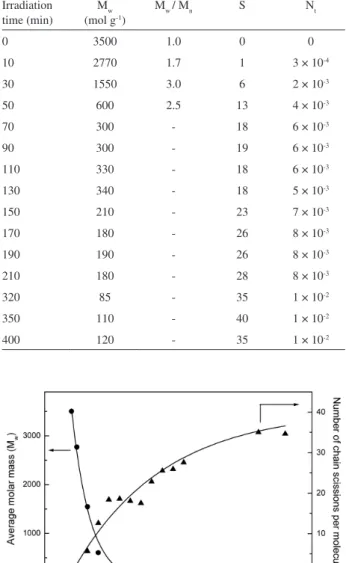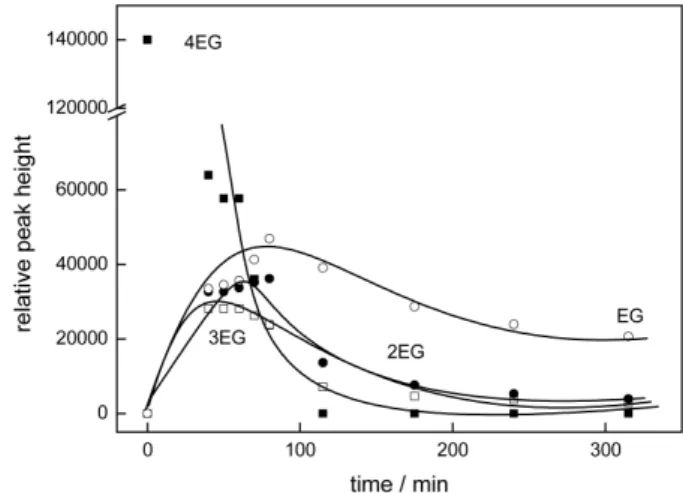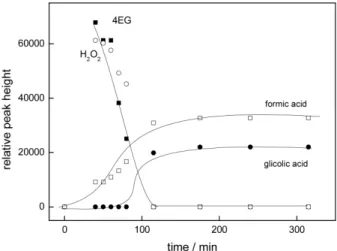Article
0103 - 5053 $6.00+0.00*e-mail: neumann@iqsc.usp.br
The UV/H
2O
2- Photodegradation of Poly(ethyleneglycol) and Model Compounds
Laís C. Santos, Alessandra L. Poli, Carla C. S. Cavalheiro and Miguel G. Neumann*
Instituto de Química de São Carlos, Universidade de São Paulo, Caixa Postal 780, 13560-970 São Carlos-SP, Brazil
O mecanismo geral para a fotodegradação do polietilenoglicol (PEG) usando o sistema H2O2/UV foi determinado por GPC e HPLC, analisando o comportamento de moléculas modelo,
como por exemplo os etilenoglicóis de baixa massa molar (tetra-, tri-, di-, e etilenoglicol). Após 30 min de irradiação, a massa molar ponderal média (Mw) do PEG degradado, analisada por GPC, cai para metade do seu valor inicial com um aumento concomitante na polidispersidade e número médio de quebra de cadeia (S). Essa queda acentuada caracteriza uma quebra de cadeia aleatória, formando oligômeros e etilenoglicóis de menor massa molar. A análise da fotodegradação de etilenoglicóis modelo por HPLC permitiu sugerir um mecanismo que envolve processos consecutivos, em que etilenoglicóis maiores originam menores, sucessivamente. A fotodegradação do etilenoglicol formou ácidos carboxílicos de baixa massa molar, como por exemplo os ácidos glicólico, oxálico e fórmico.
The general mechanism for the photodegradation of polyethyleneglycol (PEG) by H2O2/UV was determined studying the photooxidation of small model molecules, like low molecular weight ethyleneglycols (tetra-, tri-, di-, and ethyleneglycol). After 30 min of irradiation the average molar mass (Mw) of the degradated PEG, analysed by GPC, fall to half of its initial value, with a
concomitant increase in polydispersitivity and number of average chain scission (S), characterizing a random chain scission process yielding oligomers and smaller size ethyleneglycols. HPLC analysis of the photodegradation of the model ethyleneglycols proved that the oxidation mechanism involved consecutive reactions, where the larger ethyleneglycols gave rise, successively, to smaller ones. The photodegradation of ethyleneglycol lead to the formation of low molecular weight carboxylic acids, like glycolic, oxalic and formic acids.
Keywords: photooxidative degradation, H2O2/UV system, poly(ethyleneglycol),ethyleneglycols
Introduction
Studies of polymer degradation are performed with two main objectives: on one side, envisaging the improvement of the photostability and prolongation of the lifetime of polymers, and on the other side, inding methods to improve the polymer degradation, aiming to reduce pollution originated from discarded materials. Many of the synthetic polymers are not very sensitive to biodegradation and, sometimes, also very resistant to photodegradation, so that frequently additives have to be added to increase their
degradability.1
Polymer oxidation is improved by various factors, such as sunlight, ozone, heat, radiation, mechanical stress, traces of transition metal ions, water, pollutants and microorganisms. Lately, great attention has been given
to advanced oxidation processes (AOPs),2 which involve
oxidation mechanisms that are initiated by active free radicals that play the role of oxidative agents. AOPs, which may also involve photochemically initiated degradation processes, have been proposed for the treatment of ground, surface and wastewaters containing biocidal or non-biodegradable organic compounds. These processes are generally based on oxidative degradation reactions, often initiated by hydroxyl radicals generated by several methods
(UV photolysis of hydrogen peroxide, TiO2 photocatalysis,
vacuum ultraviolet (VUV) photolysis of water, Fenton
and photo-Fenton reactions).3 Due to its high oxidation
potential (E0 = +2.80 V), hydroxyl radicals oxidize almost
all organic substances and mineralize them to carbon dioxide and water.
In the presence of UV radiation (ca. 250 nm) hydrogen
organic compounds abstracting hydrogen and generating organic radicals that by addition of molecular oxygen yield peroxyl radicals. These intermediates initiate thermal chain reaction that leads to the oxidative degradation of the polymers, yielding eventually carbon dioxide, water and inorganic salts. Oxidative degradation can also be iniated by electron transfer to the hydroxyl radicals.
The hydrogen peroxide processes have several advantages over other oxidizing sources used for polymer degradation, like commercial availability, minimal capital investment, thermal stability and on-site storage, which renders them very cost-effective systems. Physical properties, like its ininite solubility in water, the lack of mass transfer problems associated with gases, and the readiness of the reactions of
the HO• radicals with most organic substrates, also contribute
to make these systems very useful.
Poly(ethyleneglycols) (PEGs) are water soluble polymers widely used in industrial and household products, as surfactants, drug release vehicles, colloidal stabilizer. Although these polymers are non toxic and biocompatible, when discarded after use, they will contribute to environmental problems and their disposal
is necessary.4 Low molecular weight ethyleneglycols can
be successfully used as model molecules to predict the
behaviour of larger molecular mass PEG’s. Glastrup5,6
studied the thermal degradation of tetraethyleneglycol under different conditions and analyzed the degradation products by gas chromatography, proposing a mechanism where formic acid and other oxidation products are formed.
McGinnis7,8 oxidized ethyleneglycol using Fenton’s reagent
and H2O2/UV, suggesting a possible pathway for the
mineralization of ethyleneglycol, going through glycolic, glyoxylic, oxalic and formic acids. Studies of the rate and extent of the oxidative degradation of diethyleneglycol by both ozone and hydrogen peroxide and a ferric salt allowed
the identiication of the main reaction products.9
In the present work, small molecular weight ethyleneglycols (tetra-, tri-, and diethyleneglycol, as well as ethyleneglycol) were used as models to predict the photo-oxidative degradation mechanism of poly(ethyleneglycol), PEG. The photooxidation reaction was initiated by UV-irradiation of hydrogen peroxide and the degradation products were analysed by high performance liquid chromatography (HPLC).
Experimental
Materials
PEG 3350 (Fluka), tetra- and triethyleneglycol (Across Organics), diethyleneglycol (Fenil Química),
and ethyleneglycol (J. T. Baker) were used as supplied. Hydrogen peroxide 30% was purchased from Merck.
Sample preparation
Hydrogen peroxide was added to solutions containing the ethyleneglycols in Milli-Q water. The solutions were placed in quartz tubes and the photodegradation processes took place in an irradiation chamber using the 254 nm emission of 96-W Ultraviolet Germicidal lamps. For the identiication and quantiication of the generated products, aliquots were withdrawn at appropriate times from the reaction lasks and analysed.
Gel permeation chromatography (GPC)
Average molar masses (Mw) were determined by GPC
on a Shimadzu LC-10 AD chromatographic system with
a Shimadzu RID – 6A refractive index detector. 100 µL
of the solutions were injected in three OHPAK KB-806M columns. Milli-Q water was used as the eluent at a low rate
of 1 mL min-1. Narrow-distribution poly(ethyleneglycol)
standards (American Polymer Standards Corp.) were used for calibration.
High performance liquid chromatography (HPLC)
Degradation products were determined using a Shimadzu LC-10 AD chromatographic system with a Rezex
00H-0138-KO Rezex 8µ 8% 300 × 7.8 mm column using
sulphuric acid 0.005 mol L-1 as mobile phase at a 0.6 mL
min-1 low rate. A Shimadzu RID – 6A refractive index
detector was used and volumes of 100 µL of sample were
injected.
The reaction products and intermediate species from EG’s and PEG photodegradation were identified by comparison with previously injected standard samples.
The presence of H2O2 did not affect the retention times of
the samples.
Results and Discussion
PEG photodegradation
GPC analysis
and the decrease of the Mw. Undegradated samples are characterized by average molar masses in the range of 3500 D. A fast drop of the molar mass can be observed
during the irst 70 min of irradiation, after which the Mw
remains practically constant (Figure 1).
The exponential decay indicates a random chain scission process rather than a depolymerization process,
which would lead to a slower decrease of the Mw.10
The number of average chain scission (S) per molecule
can be calculated from:11
S = [Mn(0)/Mn(t)] – 1 (1)
where Mn(0) and Mn(t) are the number average molar mass
of the polymer before and after t min of UV irradiation,
respectively.
The number of scission events per gram of PEG, N
t, is
calculated using 10,11
Nt = [1/Mn(t)] – [1/Mn(0)] (2)
The change of Nt for different times irradiations
is shown in Table 1 and shows an increase during the irst 70 min of irradiation. The progress of the PEG’s photodegradation processes could also be assessed by the number of average chain scissions (S) per molecule. It can
be seen in Figure 1 that S increases with irradiation time,
matching the exponential decay of the Mw, conirming a
random chain scission mechanism.
The polydispersitivity (Mw/Mn) of the UV-irradiated
samples is also shown in Table 1. It can be seen that the system starts off from a solution where all the chains have almost the same length, and under irradiation changes
to a wider distribution of Mw, indicating that the system
becomes less uniform. This behaviour is expected for degradated polymers, as irradiation will promote an
increase in the number of polymer chains, lowering the Mn,
and consequently increasing the polydispersitivity. These
results are similar to those obtained by Hoekstra et al.11 for
the oxidation of high density polyethylene (HDPE), where the oxidized polymers presented higher polydispersitivity than the original samples.
HPLC analysis
After 10 min of irradiation of the PEG samples, practically all the lower molecular weight products shown
in Table 2 were detected, i.e., 4EG, 3EG, 2EG, EG, glycolic,
oxalic and formic acids. All of them were identiied using the retention times of standard samples, as shown Figure 2.
A chromatographic peak at larger retention time (25.8 min) was also observed, suggesting the formation of
Table 1. Average molar mass (Mw), polydispersity (Mw/Mn), average chain scissions per molecule (S) and number of scission events (Nt) per gram of PEG
Irradiation time (min)
Mw (mol g-1)
Mw / Mn S Nt
0 3500 1.0 0 0
10 2770 1.7 1 3 × 10-4
30 1550 3.0 6 2 × 10-3
50 600 2.5 13 4 × 10-3
70 300 - 18 6 × 10-3
90 300 - 19 6 × 10-3
110 330 - 18 6 × 10-3
130 340 - 18 5 × 10-3
150 210 - 23 7 × 10-3
170 180 - 26 8 × 10-3
190 190 - 26 8 × 10-3
210 180 - 28 8 × 10-3
320 85 - 35 1 × 10-2
350 110 - 40 1 × 10-2
400 120 - 35 1 × 10-2
Figure 1. Evolution of the molar mass and the number of chain scissions
during photodegradation of PEG.
Table 2. Retention times for ethyleneglycols and some oxidation products
Compound Retention time (min)
Oxalic acid 8.7
Glycolic acid 15.5
H2O2 15.6
Formic acid 17.3
EG 19.8
2EG 20.7
3EG 21.6
a species with molecular weight higher than 4EG, probably an oligomer arising from a PEG scission. All the degradation products remain in solution even after 120 h of irradiation,
indicating that practically all the initially present H2O2 is
consumed during the initial 60 min of irradiation.
Photodegradation of model compounds
4EG, 3EG, 2EG and EG were used as model molecules to ascertain the degradation mechanism of the photooxidation of PEG polymers. The lower molar weight ethyleneglycols always appear as primary decomposition products in the photodegradation of PEG, so that the degradation mechanism of these smaller molecules can reasonably be extended to the photodegradation of the higher molecular weight polymers. Triethyleneglycol and tetraethyleneglycol, as well as their degradation products, are small enough to be analysed directly by HPLC. It is expected that these molecules will undergo the same type of reactions found on larger molecular weight PEG. Besides the two end hydroxyl groups they bear two vicinal ether groups which might be under the inluence of the hydroxyl groups. There is also a central ether group that should be under the only inluence
of other ether groups.6
Triethyleneglycol. The peak attributed to 3EG with retention time of 21.6 min decreases continuously during UV-irradiation, and new peaks with retention times around 20.7 and 19.8 min develop simultaneously, characterizing the formation of 2EG and EG (Figure 3).
The consumption of hydrogen peroxide is slightly faster than the simultaneous disappearance of the 3EG peak. It can be noticed that after the initial growth, the 2EG and the EG peaks start to fall off, due to their degradation process. It can also be noticed that the maximum reached by the diethyleneglycol occurs at shorter times than that
of ethyleneglycol, conirming a sequential degradation process. Formic acid, which is one of the inal products, grows steadily during all the photodegradation process. The global degradation process for triethyleneglycol can be characterized by the sequence:
3EG → 2EG → EG → formic acid (3)
Tetraethyleneglycol. After 10 min of irradiation of 4EG, the chromatograms showed the formation of 3EG, 2EG, EG, and oxalic and formic acid, simultaneous to the 4EG consumption, as shown in Figure 4. The degradation pattern is similar to that obtained for the photo-oxidation of 3EG, as well as for the other EG’s, that is, the presence of smaller EG’s and carboxylic acids simultaneous to the disappearance of the original EG.
Ethyleneglycol. The photodegradation of EG was monitored by the behaviour of the 19.8 min retention time peak (Figure 5).
Figure 2. Chromatographic analysis of ethyleneglycols and
photodegradation products.
Figure 3. Time evolution of the concentration of the reaction products
during the photodegradation of triethyleneglycol.
Figure 4a. Time evolution of the concentration of the smaller
A continuous decay is observed during the irst 60 min of irradiation and the total disappearance occurs between 240 and 570 min. Figure 2 also shows the formation of formic acid resulting from the EG degradation, reaching the highest concentration after 570 min. It was found that even after 24 and 72 h irradiation, the formic acid concentration remained constant. This can be attributed to an extremely slow photodegradation of formic acid in the
absence of H2O2, as probably all the hydrogen peroxide
was already consumed after 570 min, proving additionally that all the oxidation processes occurred via the hydrogen peroxide photodecompositon, with no contribution of reactions involving photodecompositions of any of the intermediates or inal products. Oxalic acid was found in samples irradiated for at least 570 min.
Although hydrogen peroxide has a similar retention time than glycolic acid (15.6 min), the presence of the latter during the degradation of smaller ethyleneglycols could be conirmed by HPLC. As shown in the Figure 5, the 15.6 min peak increases about 20% after 10 min of UV-irradiation and remains more or less constant up to 72 h thereafter. As hydrogen peroxide will obviously be consumed during the photodegradation process, the increase of the peak should be ascribed to the formation of the glycolic acid.
Thus, under the conditions used in this work, the hydrogen peroxide concentration can be considered to be the limiting factor for the photodegradation during the irst 3 h, after which it is totally consumed. The low molecular weight acids formed during the photodegradation (glycolic, oxalic and formic acids), continue to be present as their photodegradation is less eficient than the photodegradation of the smaller ethyleneglycols, which practically consume the whole of the oxidizing agent.
Photodegradation of carboxylic acids
The irradiation of the carboxylic acids was performed using the same conditions of the previous experiments.
Experiments carried out with the H2O2/UV system indicate
that the degradation of glycolic acid yields oxalic and formic acids. According to the mechanism proposed by
Leitner12 for the oxidation of glycolic acid,the hydroxyl
radicals formed by the UV-irradiation of H2O2 abstract
carbon-bound hydrogen atoms from the substrate. Then, the substrate radicals rapidly add oxygen, forming peroxyl
radicals that do eliminate HO2•, which initiates the
degradation chain reaction. The glyoxylic acid resulting from the oxidation of glycolic acid is transformed into oxalic acid following the same routes (Scheme 1).
Figure 4b. Time evolution of hydrogen peroxide and formic and glycolic
acid during the photodegradation of tetraethyleneglycol.
Figure 5. Photodegradation of ethyleneglycol and formation of formic
acid.
Scheme 2. Mineralization of carboxylic acids.
Scheme 3. Photodegradation pathways for PEG and small ethyleneglycols.
Although some studies 7,8,12 propose the conversion
of oxalic acid into formic acid (Scheme 2), under the conditions used in our experiments, this was not observed.
Conclusions
The present study proves that the photolysis of hydrogen peroxide is a good source of hydroxyl radicals, which lead to the photodegradation of poly(ethyleneglycol). Chromatographic analysis made it possible to demonstrated
that the H2O2/UV system is efficient in degradating
PEG, which undergoes a random chain scission process, yielding oligomers, tetraethyleneglycol, triethyleneglycol, diethyleneglycol, ethyleneglycol and its lower molecular weight decomposition products.
The smaller ethylene glycols were successfully used as model molecules to predict the PEG behaviour. Tetraethyleneglycol, as well as the other ethyleneglycols used, decomposes generating smaller ethyleneglycols. HPLC analysis also proved that the degradation of ethyleneglycol leads to glycolic, oxalic and formic acids
when irradiated in the presence of hydrogen peroxide, as shown in Scheme 3.
Acknowledgements
Financial support by FAPESP, Brazil (Proc. 03/07770-4) and CNPq, Brazil (Proc. 471310/2006-9), is gratefully acknowledged. L.C.S. also thanks FAPESP for a doctoral fellowship.
References
1. Kaczmarek, H.; Kaminska, A.; Swiatek, M.; Rabek, J. F.;
Angew. Makromol. Chem.1998, 261/262, 109.
2. Al-Malaika, S.; Int. Mat. Rev.2003, 48, 165.
3. Bossmann, S. H.; Oliveros, E.; Gob, S.; Siegwart, S.; Dahlen, E. P.; Payawan Jr, L.; Straub, M.; Worner, M.; Braun, A. M.;
J. Phys. Chem. A. 1998, 102, 5542.
4. Morlat, S.; Gardette, J. L.; Polymer 2003, 44, 7891.
5. Glastrup, J.; Padield, T.; ICOM-CC Conference, Washington DC, USA, 1993.
6. Glastrup, J.; Polym. Degrad. Stab.1996, 52, 217.
7. McGinnis, B. D.; Adams, V. D.; Middlebrooks, E. J.; Wat. Res.
2000, 34, 2346.
8. McGinnis, B. D.; Adams, V. D.; Middlebrooks, E. J.;
Chemosphere2001, 45, 101.
9. Turan-Ertas, T.; Gurol, M. D.; Chemosphere2002, 47, 293. 10. Rabek, J. F.; Photodegradation of Polymer,Springer: Berlin,
1996.
11. Hoekstra, H. D.; Spoormaker, J. L.; Breen, J.; Audoin, L.; Verdu, J.; Polym. Degrad. Stab.1995, 49, 251.
12. Leitner, N. K.V.; Doré, M.; Wat. Res.1997, 31, 1383.
Received: January 16, 2009
Web Release Date: August 20, 2009


